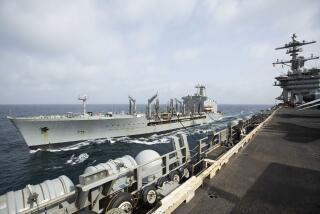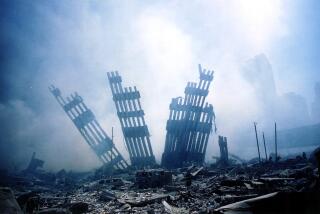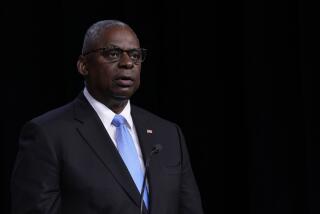U.S. Begins Inquiry Into Iraq Attack : Navy Team Arrives in Bahrain, Will Examine Damage
- Share via
MANAMA, Bahrain — A team of U.S. naval officers opened a formal investigation Thursday into the circumstances surrounding the Iraqi air attack on a U.S. Navy ship that left 37 American sailors dead.
Six officers headed by Rear Adm. Grant A. Sharp went aboard the command ship LaSalle, flagship of the U.S. Middle East Force, to begin the investigation, a Navy spokesman said. Sharp is commander of Cruiser/Destroyer Group 2, based at Charleston, S.C.
“It is a formal investigation with the purpose of inquiring into all the circumstances connected with the damage and loss of life sustained as a result of the attack on the USS Stark,” Cmdr. Michael Cherry, the Navy spokesman, told reporters.
Heightened Readiness
In Washington, President Reagan ordered U.S. Navy ships in the gulf to step up their readiness as a result of Sunday’s attack on the Stark.
The Pentagon said Thursday that the guided-missile frigate Groves, which had been scheduled to return to the United States next month, has been ordered to stay in the gulf until August.
“We want to maintain a credible presence there,” a Defense Department official said. “The Stark is out of commission, and the return of the Groves . . . would have reduced us to three guided-missile destroyers and one guided-missile frigate, in addition to the LaSalle.”
The Associated Press quoted Navy officers as saying that U.S. ships in the gulf have switched their anti-missile systems to automatic. When the Stark was hit, its rapid-fire Phalanx missile-defense system was on manual control to avoid firing on friendly aircraft.
Navy spokesman Cherry declined to provide further details about the investigation into the attack. He would not say what officers and men the investigators plan to question.
They are expected to go aboard the Stark, which is anchored alongside the LaSalle off the Bahraini coast, to examine the wreckage. Cherry noted that the unexploded warhead of a French-made Exocet missile that was found on board the Stark on Wednesday proves conclusively that at least one of the two missiles that hit the ship was an Exocet.
There has been speculation that one of the missiles was not an Exocet but a laser-guided type that could have evaded the Stark’s radar defenses.
Among the questions the Navy inquiry is expected to focus on are these:
-- Why did the Stark, which tracked the Iraqi Mirage F-1 warplane on its radar from a distance of 200 miles, allow the plane to come within 10 miles without activating defensive systems that could destroy an incoming missile?
-- How much information did the Stark have about the missile attack? The ship’s commanding officer, Capt. Glenn R. Brindel, told a news conference Wednesday that the first indication of a missile attack came from a lookout who visually sighted the missile.
-- Did the captain act properly in not initiating action against the aircraft when it failed to respond to two radio messages asking for identification? Brindel said that two to three minutes elapsed between the second radio warning and the missile attack.
-- Was correct procedure followed in warning the Iraqi plane, and was the Iraqi pilot tuned in to the international distress frequency on which the warnings were broadcast? Brindel told reporters Wednesday that the Stark frequently communicated with Iranian pilots, but he made no mention of any contacts with Iraqi pilots.
Both Brindel and the commander of U.S. forces in the region have said that Iraqi aircraft, which regularly attack Iranian shipping in the gulf, are generally regarded by the U.S. Navy as “friendly aircraft” and that no action would be directed against them in the absence of a show of hostile intent.
Brindel said at his press conference that the ship’s Phalanx system was being switched from manual to automatic mode when the first of two missiles struck. (On Thursday, United Press International quoted two Navy technicians as saying that the Stark’s Phalanx system was not working just a day before the attack, when the frigate was in port. The technicians, requesting anonymity, said sailors from the Stark asked them for a spare part for the Phalanx “and we didn’t have it,” adding, “They never had it fixed.”)
Cherry, the Navy spokesman, said the Stark “had no major engineering problems before it set out.”
A Pentagon spokesman said Thursday that the Iraqi warplane that attacked the Stark took off from Shuaiba air base near Basra.
In Baghdad, Iraqi Foreign Minister Tarik Aziz said an American team was expected to arrive there to compare notes with Iraqi officials about the incident and to “reach the final story” of what happened.
Aziz said in an interview for American television that the pilot of the attacking jet had told Iraqi officials that he believed he was attacking an Iranian ship.
He said the pilot did not learn that he had hit an American ship until after returning to his base.
Asked whether Iraq would compensate the families of the American servicemen who died in the incident, Aziz said: “Yes, I can say we are prepared to do that. We will respect our obligations in this respect.”
More to Read
Sign up for Essential California
The most important California stories and recommendations in your inbox every morning.
You may occasionally receive promotional content from the Los Angeles Times.










